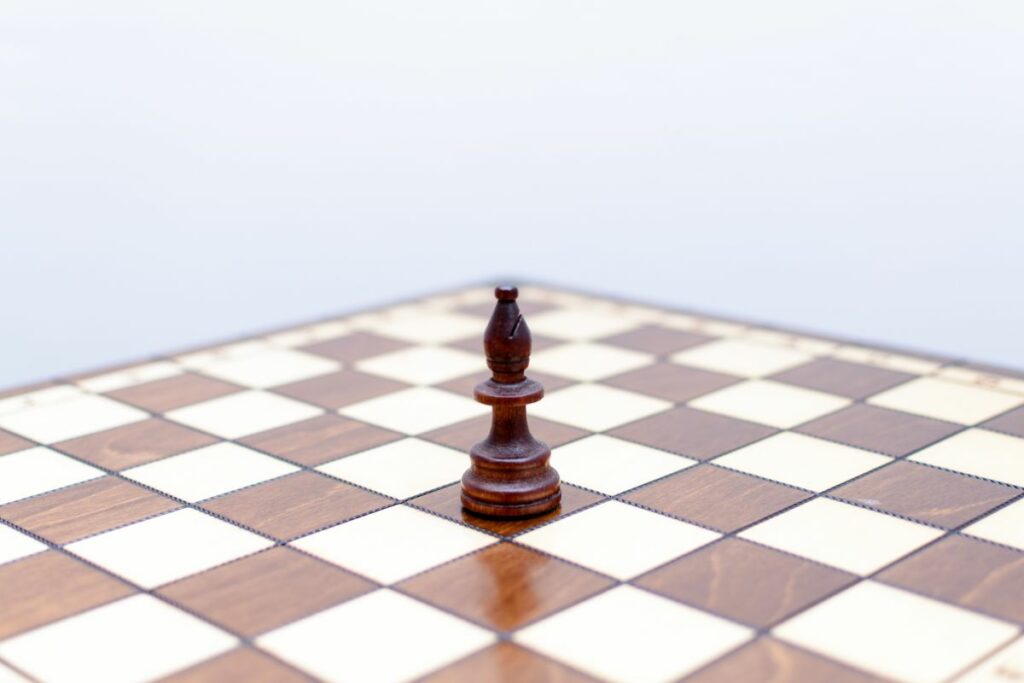Once you have mastered the basic rules of chess, you’ll want to start learning everything you make about the other pieces – one of which is the bishop.
To develop a complete and balanced chess game, you’ll want to understand the tactics and movements of the other pieces.

Today, we will be focusing on the bishop. When properly deployed, the long-range bishop can be surprisingly powerful.
With this in mind, this article will explore everything you need to know about the bishop and how it moves in chess.
Let’s get straight into it.
What Is A Bishop?
The bishop can be identified by its rounded top with a slit cut into it. On the chessboard, there are a total of four bishops – whereby each player has two allocated bishops.
The kingside bishop is positioned between the knight and the king, while the queenside bishop is placed between the queen and the knight.
In terms of chess, the bishop has a value of three – making it equal relative in value to the knight. That said, it holds less value than the rook – who can move in any direction, horizontally or vertically, and isn’t confined to one square color.
Moreover, it is the only piece, besides the king of the queen, that can move diagonally in any direction (a pawn can move diagonally although only when capturing another article).
How Do Bishops Move?
A bishop is able to move in straight lines diagonally – going both forward and backward. In a game of chess, both players have two bishops; one that only moves on the dark squares, and one that moves only on the light squares.
For instance, the bishop on the light-colored squares can only move in a diagonal direction along the same colored squares.
On the other hand, the bishop on the dark-colored squares can only move in a diagonal direction along the dark squares.
In addition, the bishop is able to move freely across the squares in a diagonal direction as long as the other squares aren’t occupied.
Moreover, keep in mind that even if it is your piece blocking the bishop’s path, you can’t go past it.
5 Tips When Using Your Bishop
Those who know how to unleash the full power of the bishop have a distinct advantage over their opponents. Below, we have outlined some general bishop tacts that you can use to improve your chess-playing skills.
Good Bishops Vs. Bad Bishops
Depending on the position of a bishop relative to their pawns, they’re either referred to as “good” or “bad” bishops.
For instance, if most of your pawns are on the same colored squares as your bishop, then this bishop is generally referred to as the “bad” bishop – this is because its influence and movement are restricted by the pawns.
On the other hand, the bishop that sits opposite the colors of the majority of pawns is referred to as the “good” bishop – this is because it can exert more influence and move around more freely on the chessboard.
Even though the “good” bishop is considered more beneficial on the chessboard, the “bad” bishop can sometimes be useful when it comes to defending a particular pawn.
Look For Open Diagonals
You can get the most out of your bishop by placing it somewhere open with a long diagonal range – essentially, you’ll want to maximize space by ensuring nothing is obstructing its path.
As opposed to a knight – which is most efficient in the middle of the chess board – the bishop can exert significant influence when placed on the corners of the board with ample space to move around.
Since bishops are obstructed by the pawns once the game begins, they are often the most effective in the middle of the games – once you have had the chance to move the other pieces and a path has been cleared for the bishop to move into.
Fianchetto
If you’re looking to create quick development of your bishop, then the fianchetto is a technique used by chess players to achieve this.
Firstly, you’ll want to move the pawns on the b- or g-file one or two squares ahead. Once you have moved to pawns, the bishop can go onto the second rank.
By doing this you’re creating control in the middle of the board and also providing your king with a solid wall of defense.
For anyone playing the white pieces, this technique can create pressure on the opponent’s development.
On the other hand, for those playing the black pieces, this technique can help you create a counter-attack and exert control over the middle of the board.
Maximize Active Bishops
Those bishops that are able to move freely without being restricted by pawns are known as active bishops.
On the other hand, a bishop that is trapped behind a wall of pawns is known as a passive bishop.
Regardless of whether it is a “good” or “bad” bishop – they can both be passive. That said, active bishops are more advantageous thanks to their range and flexibility.
Bishops In The Endgame
Bishops can also be beneficial in the endgame. Thanks to the bishop’s long range, you can protect your pawns while threatening your opponents at the same time – allowing you to promote your pawns and eventually call checkmate.
Final Thoughts
Having full control of your chess pieces during a game is important. Therefore, the first thing you need to understand is how each piece works and the different techniques associated with them.
One such chess piece involves the bishop. When used properly, the bishop can be extremely advantageous in a particular game. Not only do they provide you with range but can help protect your pieces, too.
Hopefully, this guide has informed you on everything you need to know about the bishop and how it moves in a game of chess.
- Is Chess.com Premium Worth It? - May 25, 2023
- How To Set Traps In Chess? - May 25, 2023
- Chess.com Review - May 25, 2023
